The Saint of the Day
 |
 |
 |
 |
 |
 |
 |
St. Francis Solanus - July 14
Biographical selection:
St. Francis Solanus was a Franciscan missionary to South America called by Divine Providence to be part of the Spanish Counter-Reformation. He was born in Montilla, Andaluzia, in 1549 into a noble family. His father was twice governor of Montilla, capital of the Marquisate of Priego de Córdoba. His mother was known as "the noble lady" for both her high family lines and practice of virtue.
Even before he was born, this "noble lady" consecrated her son to St. Francis of Assisi, hence his name. He received from his parents a Catholic formation, which was completed it in the Jesuit College of his city.
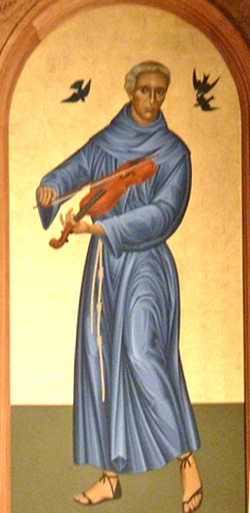 He was a tall man gifted with amiability, a beautiful voice and a rare musical sense.
He was a tall man gifted with amiability, a beautiful voice and a rare musical sense.
Under Catholic King Phillip II, a true religious renaissance blossomed in Spain. In the Franciscan Order, St. Peter of Alcantara shone with a special brilliance, and, influenced by this Saint, Solanus entered the Franciscan Order.
He was noted for his practice of virtue and for not permitting any friar to show sadness in the service of God.
He would play the violin and sing before the Blessed Sacrament and the statue of Our Lady. When he traveled, he never left behind either his cilice or his violin. Often he would walk through the streets playing his violin to the great joy of the children who would gather around to listen to his music.
His fame of holiness spread throughout Spain. To avoid this celebrity, he requested his superiors to send him to the Americas to preach the Gospel. There he worked at evangelizing regions of Panama, Colombia, Peru, Paraguay, Bolivia and Argentina, often traveling by foot.
He spent a good part of his life in Lima, Peru, where the Franciscan Order was blooming. At the time he lived in Lima, the Archbishop was St. Toribio of Mogrovejo and the third order tertiary St. Rose of Lima was practicing great austerities and helping the poor from her family home.
As he was becoming famous for his virtue and miracles, once again he fled. This time he was sent to Tucuman (in present day Argentina) where he did not fear to approach the fiercest Indians. One day, walking through the forest, he felt himself watched. He stopped by a spring to rest and, hearing the birds singing, he took out his violin to accompany their songs. As he did so, an Indian emerged from the dense forest threatening the Saint.
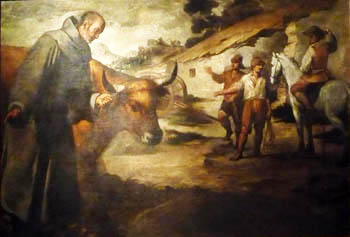 The Saint calmly approached him playing his violin, and the man – who was the tribal chief – was moved by the music, and invited St. Francis Solanus to visit his tribe. He preached to the Indians in Spanish and they – who did not know this language – understood him perfectly. The Saint worked many miracles, and the Indians converted.
The Saint calmly approached him playing his violin, and the man – who was the tribal chief – was moved by the music, and invited St. Francis Solanus to visit his tribe. He preached to the Indians in Spanish and they – who did not know this language – understood him perfectly. The Saint worked many miracles, and the Indians converted.
For 13 years he remained in that region. He made peace between the colonists and the Indians, bringing both to the Catholic Faith. He resurrected the dead, healed mortal illnesses, tamed wild beasts and made fountains spring from the earth. He became venerated by both the Indians and colonists throughout the area.
He was known for his practice of rigorous penances and fasting. Around 1601 he was called back to Lima, where he tried to recall the Spanish colonists to a more fervent practice of the Faith. He died there in 1610.
When he felt his life was ending, he asked the friars to sing the Magnificat and the Credo. At the words: "Et incarnatus est de Spiritu Sancto ex Maria Virgine" (and He became incarnate by the Holy Ghost from the Virgin Mary), he expired. At that moment, the bells of the monastery announced the Elevation of the Holy Host at the Mass.
Comments of Prof. Plinio:
The union of nobility of blood and nobility of virtue seen in the mother of the Saint evokes a type of lady who was extraordinarily virtuous and dignified in the past. In these virtuous ladies there was a marvelous alliance between an elevation of soul and a refinement of manners so exquisite that their high courtesy was not only an external display of fine gestures and actions, but also the very expression of their high nobility of soul.
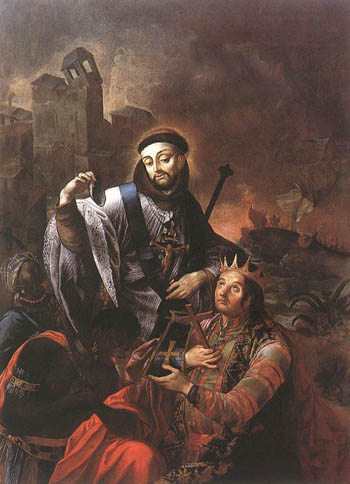 The mother of the Saint, called "the noble lady" par excellence, had the vocation to form this missionary who would evangelize the most primitive Indians of South America. This contrast of customs is obviously by the designs of Divine Providence. How many times in his dealings with the uncouth and non-hygienic habits of those Indians, would St. Francis Solanus have recalled his noble mother walking through the streets of Montilla in the Marquisate of Priego, his childhood home. This contrast has a beauty that we should note in passing.
The mother of the Saint, called "the noble lady" par excellence, had the vocation to form this missionary who would evangelize the most primitive Indians of South America. This contrast of customs is obviously by the designs of Divine Providence. How many times in his dealings with the uncouth and non-hygienic habits of those Indians, would St. Francis Solanus have recalled his noble mother walking through the streets of Montilla in the Marquisate of Priego, his childhood home. This contrast has a beauty that we should note in passing.
The Saint used to censure those who were sad in the practice of virtue. He would not admit complaints like these: "How hard life is!" "See how I, a poor religious man, am suffering…" When a person starts to pity himself, he enters the path that ends in apostasy. It is necessary to have joy in serving God, to communicate the joy for holy things.
St. Thomas Aquinas calls the lack of appetite for holy things assedia, which is, therefore, a sadness in the service of God. St. Francis Solanus received the rare grace to communicate a joy for holy things. Today we are in an epoch where only joy for the things of the world exists. Almost no one has the joy of virtue, the joy of serving Our Lord and Our Lady. St. Francis Solanus was called by God to communicate this joy.
This does not mean he would tell jokes and do foolish things. He had the joy of seriousness, which is the noblest and highest of all joys.
When he would travel, he would carry with him his cilice and his violin. This harmony seems very expressive to me. For a religious man, the violin without the cilice is the sure path to apostasy; the cilice without the violin loses some of its advantages, because one of the reasons for the use of the cilice is to generate joy for the service of God.
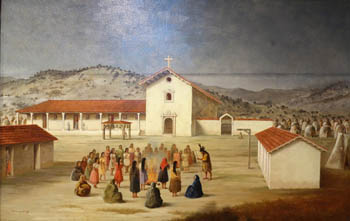 It is like the soldier who goes joyfully to the fight. A soldier who weeps as he goes off to war because he is leaving his home and family is prepared to retreat. He who weeps, retreats. What is beautiful is the soldier who goes joyfully to face danger and even death in the spirit of sacrifice.
It is like the soldier who goes joyfully to the fight. A soldier who weeps as he goes off to war because he is leaving his home and family is prepared to retreat. He who weeps, retreats. What is beautiful is the soldier who goes joyfully to face danger and even death in the spirit of sacrifice.
This should be the life of the religious man, and also of the counter-revolutionary. He is joyful in fulfilling his duties, in suffering for his cause; he is glad to belong entirely to Our Lady. He is joyful because he became her slave and has nothing; and, because of this, he has everything.
Violin and cilices: I think it is a magnificent combination!
He had the highest respect for the ceremonies of the liturgy and, at the same time, he would walk through the streets to play his violin for the people, who would gather around to hear his performances. His enormous soul could encompass the two extremes – the solemnity of the liturgy and the simplicity of popular songs. I like these grand souls, open, capable of becoming enthused with extreme harmonic contraries. Such was the soul of St. Francis Solanus.
In the streets, he would attract the children. Then, I imagine him stopping his violin performance to give a short lesson on religion to the children. After the children had gathered, the adults would come. Then, he would change his lesson to accommodate those adults and try to correct their bad customs and habits. In this way, he would also captivate the adults. It was a perfect apostolate.
After leaving Spain he came to South America to evangelize the Indians. It is quite easy to report that he travelled by foot. But if we stop a little to imagine what this means, we can see that it was very hard.
Of course he would take boats to travel the rivers; but then he had to walk through the Andes with its torturous topography, going up and down, slipping in the wet mud and falling, fighting off all kind of insects and cutting paths through wild vegetation that had never been walked before. This is how the Saint went from Panama to Paraguay and on to Argentina to make an apostolate in Tucuman!
 When we consider that in the Lima of his time three Saints were living, we can see that this was the starting point of the History of South America, and we can imagine what could have been its end point…
When we consider that in the Lima of his time three Saints were living, we can see that this was the starting point of the History of South America, and we can imagine what could have been its end point…
When he became popular in one place, he asked to be transferred to another, always fleeing fame. It is the opposite of the contemporary politician! St. Bernard used to say that the glory is like a shadow: When we flee it, it follows us; when we chase it, it flees…
So, he went to Tucuman to meet the fiercest tribe of Indians. The selection says that he was walking in the forest and felt himself being watched. The Indians do this: hidden in the forest they watch the stranger and when the person is alone and far from help, they kill him.
The Saint walked to a spring to quench his thirst and to rest a bit, listening to the songs of the birds. Then, he resolved to play the violin to accompany the birdsong and the murmur of the water. He realized that he could be attacked as he played his music, but his soul was peaceful in the knowledge that he would die for the Faith and go to Heaven.
But, instead of martyrdom, a face appeared among the branches. It was the face of the Indian chief of the tribe he wanted to evangelize. The Indian, touched by grace, approached Francis and invited him to visit his tribe; in this way the evangelization of that entire Indian nation started.
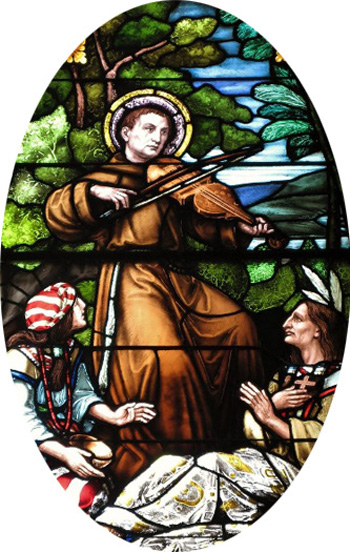 I consider this a marvel! It is a marvel similar to those in the life of St. Francis of Assisi.
I consider this a marvel! It is a marvel similar to those in the life of St. Francis of Assisi.
He went to the tribe, but he did not speak their language. He spoke Spanish, but the Holy Ghost gave him the gift of tongues so the Indians could understand what he said. This was his apostolate. What more can we ask?
A man who resurrects the dead and who can be understood by those who speak different languages! These are the men who found nations. St. Francis Solanus was the founder of a nation. How many other beautiful facts like these we can recount about Ven. José de Anchieta, who was in this sense the founder of Brazil! How beautiful was the starting point of Argentina, Peru, Brazil – of Latin America! But what has been the end point?
Is it not true, my dear friends, that, if we were to correspond to our counter-revolutionary call, the end point would be as beautiful as the starting point – or even more beautiful? We are the continuation of this History. How many promises are in our hands! Also, what a responsibility we bear if we do not correspond to the grace!
It is a task to be taken up by each individual: From the goodness and the dedication of each one of us, a noticeable progress or decay of the ensemble can depend. This is the way it is. We should ponder upon this point.
With these considerations, I end my commentary on the extraordinary life of St. Francis Solanus.


The Saint of the Day features highlights from the lives of saints based on comments made by the late Prof. Plinio Corrêa de Oliveira. Following the example of St. John Bosco who used to make similar talks for the boys of his College, each evening it was Prof. Plinio’s custom to make a short commentary on the lives of the next day’s saint in a meeting for youth in order to encourage them in the practice of virtue and love for the Catholic Church. TIA thought that its readers could profit from these valuable commentaries.
The texts of both the biographical data and the comments come from personal notes taken by Atila S. Guimarães from 1964 to 1995. Given the fact that the source is a personal notebook, it is possible that at times the biographic notes transcribed here will not rigorously follow the original text read by Prof. Plinio. The commentaries have also been adapted and translated for TIA’s site.
St. Francis Solanus was a Franciscan missionary to South America called by Divine Providence to be part of the Spanish Counter-Reformation. He was born in Montilla, Andaluzia, in 1549 into a noble family. His father was twice governor of Montilla, capital of the Marquisate of Priego de Córdoba. His mother was known as "the noble lady" for both her high family lines and practice of virtue.
Even before he was born, this "noble lady" consecrated her son to St. Francis of Assisi, hence his name. He received from his parents a Catholic formation, which was completed it in the Jesuit College of his city.

Francis Solanus accompanying the birds with his violin
Under Catholic King Phillip II, a true religious renaissance blossomed in Spain. In the Franciscan Order, St. Peter of Alcantara shone with a special brilliance, and, influenced by this Saint, Solanus entered the Franciscan Order.
He was noted for his practice of virtue and for not permitting any friar to show sadness in the service of God.
He would play the violin and sing before the Blessed Sacrament and the statue of Our Lady. When he traveled, he never left behind either his cilice or his violin. Often he would walk through the streets playing his violin to the great joy of the children who would gather around to listen to his music.
His fame of holiness spread throughout Spain. To avoid this celebrity, he requested his superiors to send him to the Americas to preach the Gospel. There he worked at evangelizing regions of Panama, Colombia, Peru, Paraguay, Bolivia and Argentina, often traveling by foot.
He spent a good part of his life in Lima, Peru, where the Franciscan Order was blooming. At the time he lived in Lima, the Archbishop was St. Toribio of Mogrovejo and the third order tertiary St. Rose of Lima was practicing great austerities and helping the poor from her family home.
As he was becoming famous for his virtue and miracles, once again he fled. This time he was sent to Tucuman (in present day Argentina) where he did not fear to approach the fiercest Indians. One day, walking through the forest, he felt himself watched. He stopped by a spring to rest and, hearing the birds singing, he took out his violin to accompany their songs. As he did so, an Indian emerged from the dense forest threatening the Saint.

Famous for his miracles, Francis tamed a raging bull that had killed several villagers
For 13 years he remained in that region. He made peace between the colonists and the Indians, bringing both to the Catholic Faith. He resurrected the dead, healed mortal illnesses, tamed wild beasts and made fountains spring from the earth. He became venerated by both the Indians and colonists throughout the area.
He was known for his practice of rigorous penances and fasting. Around 1601 he was called back to Lima, where he tried to recall the Spanish colonists to a more fervent practice of the Faith. He died there in 1610.
When he felt his life was ending, he asked the friars to sing the Magnificat and the Credo. At the words: "Et incarnatus est de Spiritu Sancto ex Maria Virgine" (and He became incarnate by the Holy Ghost from the Virgin Mary), he expired. At that moment, the bells of the monastery announced the Elevation of the Holy Host at the Mass.
Comments of Prof. Plinio:
The union of nobility of blood and nobility of virtue seen in the mother of the Saint evokes a type of lady who was extraordinarily virtuous and dignified in the past. In these virtuous ladies there was a marvelous alliance between an elevation of soul and a refinement of manners so exquisite that their high courtesy was not only an external display of fine gestures and actions, but also the very expression of their high nobility of soul.

St. Francis Solanus baptizing a native chief
The Saint used to censure those who were sad in the practice of virtue. He would not admit complaints like these: "How hard life is!" "See how I, a poor religious man, am suffering…" When a person starts to pity himself, he enters the path that ends in apostasy. It is necessary to have joy in serving God, to communicate the joy for holy things.
St. Thomas Aquinas calls the lack of appetite for holy things assedia, which is, therefore, a sadness in the service of God. St. Francis Solanus received the rare grace to communicate a joy for holy things. Today we are in an epoch where only joy for the things of the world exists. Almost no one has the joy of virtue, the joy of serving Our Lord and Our Lady. St. Francis Solanus was called by God to communicate this joy.
This does not mean he would tell jokes and do foolish things. He had the joy of seriousness, which is the noblest and highest of all joys.
When he would travel, he would carry with him his cilice and his violin. This harmony seems very expressive to me. For a religious man, the violin without the cilice is the sure path to apostasy; the cilice without the violin loses some of its advantages, because one of the reasons for the use of the cilice is to generate joy for the service of God.

The last California mission founded on July 4, 1823, is San Francisco Solano. It was restored in 1913
This should be the life of the religious man, and also of the counter-revolutionary. He is joyful in fulfilling his duties, in suffering for his cause; he is glad to belong entirely to Our Lady. He is joyful because he became her slave and has nothing; and, because of this, he has everything.
Violin and cilices: I think it is a magnificent combination!
He had the highest respect for the ceremonies of the liturgy and, at the same time, he would walk through the streets to play his violin for the people, who would gather around to hear his performances. His enormous soul could encompass the two extremes – the solemnity of the liturgy and the simplicity of popular songs. I like these grand souls, open, capable of becoming enthused with extreme harmonic contraries. Such was the soul of St. Francis Solanus.
In the streets, he would attract the children. Then, I imagine him stopping his violin performance to give a short lesson on religion to the children. After the children had gathered, the adults would come. Then, he would change his lesson to accommodate those adults and try to correct their bad customs and habits. In this way, he would also captivate the adults. It was a perfect apostolate.
After leaving Spain he came to South America to evangelize the Indians. It is quite easy to report that he travelled by foot. But if we stop a little to imagine what this means, we can see that it was very hard.
Of course he would take boats to travel the rivers; but then he had to walk through the Andes with its torturous topography, going up and down, slipping in the wet mud and falling, fighting off all kind of insects and cutting paths through wild vegetation that had never been walked before. This is how the Saint went from Panama to Paraguay and on to Argentina to make an apostolate in Tucuman!

The untamed mountains of Tucuman were not easy to cross by foot
When he became popular in one place, he asked to be transferred to another, always fleeing fame. It is the opposite of the contemporary politician! St. Bernard used to say that the glory is like a shadow: When we flee it, it follows us; when we chase it, it flees…
So, he went to Tucuman to meet the fiercest tribe of Indians. The selection says that he was walking in the forest and felt himself being watched. The Indians do this: hidden in the forest they watch the stranger and when the person is alone and far from help, they kill him.
The Saint walked to a spring to quench his thirst and to rest a bit, listening to the songs of the birds. Then, he resolved to play the violin to accompany the birdsong and the murmur of the water. He realized that he could be attacked as he played his music, but his soul was peaceful in the knowledge that he would die for the Faith and go to Heaven.
But, instead of martyrdom, a face appeared among the branches. It was the face of the Indian chief of the tribe he wanted to evangelize. The Indian, touched by grace, approached Francis and invited him to visit his tribe; in this way the evangelization of that entire Indian nation started.

St Francis Solanus, often depicted with his violin playing for the Indians
He went to the tribe, but he did not speak their language. He spoke Spanish, but the Holy Ghost gave him the gift of tongues so the Indians could understand what he said. This was his apostolate. What more can we ask?
A man who resurrects the dead and who can be understood by those who speak different languages! These are the men who found nations. St. Francis Solanus was the founder of a nation. How many other beautiful facts like these we can recount about Ven. José de Anchieta, who was in this sense the founder of Brazil! How beautiful was the starting point of Argentina, Peru, Brazil – of Latin America! But what has been the end point?
Is it not true, my dear friends, that, if we were to correspond to our counter-revolutionary call, the end point would be as beautiful as the starting point – or even more beautiful? We are the continuation of this History. How many promises are in our hands! Also, what a responsibility we bear if we do not correspond to the grace!
It is a task to be taken up by each individual: From the goodness and the dedication of each one of us, a noticeable progress or decay of the ensemble can depend. This is the way it is. We should ponder upon this point.
With these considerations, I end my commentary on the extraordinary life of St. Francis Solanus.

 | |
|
|
The texts of both the biographical data and the comments come from personal notes taken by Atila S. Guimarães from 1964 to 1995. Given the fact that the source is a personal notebook, it is possible that at times the biographic notes transcribed here will not rigorously follow the original text read by Prof. Plinio. The commentaries have also been adapted and translated for TIA’s site.


